WiFi authentication with FreeRADIUS and Google LDAP
-
Hello,
I'm having issues in using pfSense 2.4.4p2 and its FreeRADIUS package to implement 802.1x authentication on wired and wireless networks with dynamic VLAN allocation, with users declared in Google Cloud Identity.
I've defined a LDAP client in Google's console, given it the correct right to read user and group informations and verify user credentials, and I've imported the certificates in pfSense's Certificate Manager.
I've tried several different configurations in FreeRADIUS, but no matter what I configure I'm unable to authenticate my client and I'm not getting an IP address. I've checked Google's LDAP audit logs and I see FreeRADIUS successfully binding and executing a search for the user I'm trying to log on as.
I've looked at https://docs.netgate.com/pfsense/en/latest/usermanager/google-gsuite-auth-source.html but that page is for a different use case than the one I'm trying to implement.
I've managed to implement 802.1x with the same pfSense + FreeRADIUS setup and Unifi UAP-AC-PRO access points, but I had to configure users and password in FreeRADIUS itself.
Has anyone managed to make it work with Google LDAP?
Thanks in advance for any help.
-
I don't think that FreeRADIUS+LDAP supports using LDAP client certificates, which is required by Google LDAP. Maybe try the stunnel method explained in the doc, but point FreeRADIUS at the local end of the stunnel connection.
-
I've tried the stunnel method, it successfully binds to Google LDAP but I get the same kind of errors:
Feb 22 16:19:45 radiusd 68008 rlm_ldap (ldap): Opening additional connection (9), 1 of 2 pending slots used Feb 22 16:19:45 stunnel LOG5[12]: Service [Google LDAP] accepted connection from 127.0.0.1:20026 Feb 22 16:19:45 stunnel LOG6[12]: s_connect: connecting 216.239.32.58:636 Feb 22 16:19:45 stunnel LOG5[12]: s_connect: connected 216.239.32.58:636 Feb 22 16:19:45 stunnel LOG5[12]: Service [Google LDAP] connected remote server from 192.168.4.133:20553 Feb 22 16:19:45 stunnel LOG6[12]: SNI: sending servername: ldap.google.com Feb 22 16:19:45 stunnel LOG6[12]: Peer certificate not required Feb 22 16:19:45 stunnel LOG6[12]: TLS connected: previous session reused Feb 22 16:19:45 stunnel LOG6[12]: TLSv1.2 ciphersuite: ECDHE-RSA-AES128-GCM-SHA256 (128-bit encryption) Feb 22 16:19:46 radiusd 68008 Need 1 more connections to reach min connections (5) Feb 22 16:19:46 radiusd 68008 rlm_ldap (ldap): Opening additional connection (10), 1 of 1 pending slots used Feb 22 16:19:46 stunnel LOG5[13]: Service [Google LDAP] accepted connection from 127.0.0.1:64932 Feb 22 16:19:46 stunnel LOG6[13]: s_connect: connecting 216.239.32.58:636 Feb 22 16:19:46 stunnel LOG5[13]: s_connect: connected 216.239.32.58:636 Feb 22 16:19:46 stunnel LOG5[13]: Service [Google LDAP] connected remote server from 192.168.4.133:9142 Feb 22 16:19:46 stunnel LOG6[13]: SNI: sending servername: ldap.google.com Feb 22 16:19:46 stunnel LOG6[13]: Peer certificate not required Feb 22 16:19:46 stunnel LOG6[13]: TLS connected: previous session reused Feb 22 16:19:46 stunnel LOG6[13]: TLSv1.2 ciphersuite: ECDHE-RSA-AES128-GCM-SHA256 (128-bit encryption) Feb 22 16:19:47 radiusd 68008 (98) Login incorrect (eap_md5: Cleartext-Password is required for EAP-MD5 authentication): [myuser@example.com] (from client ap01 port 0 cli 3C-28-6D-27-66-34 via TLS tunnel) myuser@example.com Feb 22 16:19:47 radiusd 68008 (99) eap_peap: This means you need to read the PREVIOUS messages in the debug output Feb 22 16:19:47 radiusd 68008 (99) eap_peap: to find out the reason why the user was rejected Feb 22 16:19:47 radiusd 68008 (99) eap_peap: Look for "reject" or "fail". Those earlier messages will tell you Feb 22 16:19:47 radiusd 68008 (99) eap_peap: what went wrong, and how to fix the problem Feb 22 16:19:47 radiusd 68008 (99) Login incorrect (eap_peap: The users session was previously rejected: returning reject (again.)): [myuser@example.com] (from client ap01 port 0 cli 3C-28-6D-27-66-34) myuser@example.com Feb 22 16:19:55 radiusd 68008 (108) Login incorrect (eap_md5: Cleartext-Password is required for EAP-MD5 authentication): [myuser@example.com] (from client ap01 port 0 cli 3C-28-6D-27-66-34 via TLS tunnel) myuser@example.com Feb 22 16:19:55 radiusd 68008 (109) eap_peap: This means you need to read the PREVIOUS messages in the debug output Feb 22 16:19:55 radiusd 68008 (109) eap_peap: to find out the reason why the user was rejected Feb 22 16:19:55 radiusd 68008 (109) eap_peap: Look for "reject" or "fail". Those earlier messages will tell you Feb 22 16:19:55 radiusd 68008 (109) eap_peap: what went wrong, and how to fix the problem Feb 22 16:19:55 radiusd 68008 (109) Login incorrect (eap_peap: The users session was previously rejected: returning reject (again.)): [myuser@example.com] (from client ap01 port 0 cli 3C-28-6D-27-66-34) myuser@example.com Feb 22 16:19:56 radiusd 68008 (118) Login incorrect (eap_md5: Cleartext-Password is required for EAP-MD5 authentication): [myuser@example.com] (from client ap01 port 0 cli 3C-28-6D-27-66-34 via TLS tunnel) myuser@example.com Feb 22 16:19:56 radiusd 68008 (119) eap_peap: This means you need to read the PREVIOUS messages in the debug output Feb 22 16:19:56 radiusd 68008 (119) eap_peap: to find out the reason why the user was rejected Feb 22 16:19:56 radiusd 68008 (119) eap_peap: Look for "reject" or "fail". Those earlier messages will tell you Feb 22 16:19:56 radiusd 68008 (119) eap_peap: what went wrong, and how to fix the problem Feb 22 16:19:56 radiusd 68008 (119) Login incorrect (eap_peap: The users session was previously rejected: returning reject (again.)): [myuser@example.com] (from client ap01 port 0 cli 3C-28-6D-27-66-34) myuser@example.comThe password is definitely OK, since in Diagnostics > Authentication the same login and password work perfectly.
I've also tried to add a user in the User Manager whose login is the same as the uid in Google LDAP, but without any password, and I get the following error:
Feb 22 16:24:35 radiusd 57636 rlm_ldap (ldap): Opening additional connection (1), 1 of 4 pending slots used Feb 22 16:24:35 stunnel LOG5[23]: Service [Google LDAP] accepted connection from 127.0.0.1:17158 Feb 22 16:24:35 stunnel LOG6[23]: s_connect: connecting 216.239.32.58:636 Feb 22 16:24:35 stunnel LOG5[23]: s_connect: connected 216.239.32.58:636 Feb 22 16:24:35 stunnel LOG5[23]: Service [Google LDAP] connected remote server from 192.168.4.133:59393 Feb 22 16:24:35 stunnel LOG6[23]: SNI: sending servername: ldap.google.com Feb 22 16:24:35 stunnel LOG6[23]: Peer certificate not required Feb 22 16:24:35 stunnel LOG6[23]: TLS connected: previous session reused Feb 22 16:24:35 stunnel LOG6[23]: TLSv1.2 ciphersuite: ECDHE-RSA-AES128-GCM-SHA256 (128-bit encryption) Feb 22 16:24:36 radiusd 57636 (6) Login incorrect (eap_md5: Cleartext-Password is required for EAP-MD5 authentication): [myuser@example.com] (from client ap01 port 0 cli 3C-28-6D-27-66-34 via TLS tunnel) myuser@example.com Feb 22 16:24:36 radiusd 57636 (6) Login incorrect (eap: Failed continuing EAP TTLS (21) session. EAP sub-module failed): [myuser@example.com] (from client ap01 port 0 cli 3C-28-6D-27-66-34) myuser@example.comI can't see what I'm doing wrong, it seems like I'm close to a solution but there are some missing steps which I'm not getting.
-
Were you able to get this to work?
We are using Google Cloud Identity to authenticate with the pfSense and OpenVPN but we would like to add two-factor authentication. Thinking if we could point FreeRADIUS to Google Cloud Identity, we could then layer on 2FA.
Any help or suggestions would be appreciated.
-
Unfortunately I couldn't get this to work, and I've since then left that company so I don't know if they've managed to make it work.
-
@datafaber & @weehooey So I have freeradius3 working on my pfsense fw, both as a ldap authentication under user manager and ldap over ssl with bind to ldap.google.com using google provided cert.
It involved manually editing the conf files, if you make any changes in the web ui it will over write with the incorrect settings.
I am documenting this as I need to take this from test env to real even for 2fa.https://www.nasirhafeez.com/freeradius-with-google-g-suite-workspace-secure-ldap-for-wpa2-enterprise-wifi/
following this article I was able to get an ubuntu vm running and connecting freeradius3 to google ldap. then adapting it to follow how the pfsense freeradius wants it.I uploaded the crt and key into cert manager on pfsense.
defined everything in the gui like bind user / passSetup the two interface ports
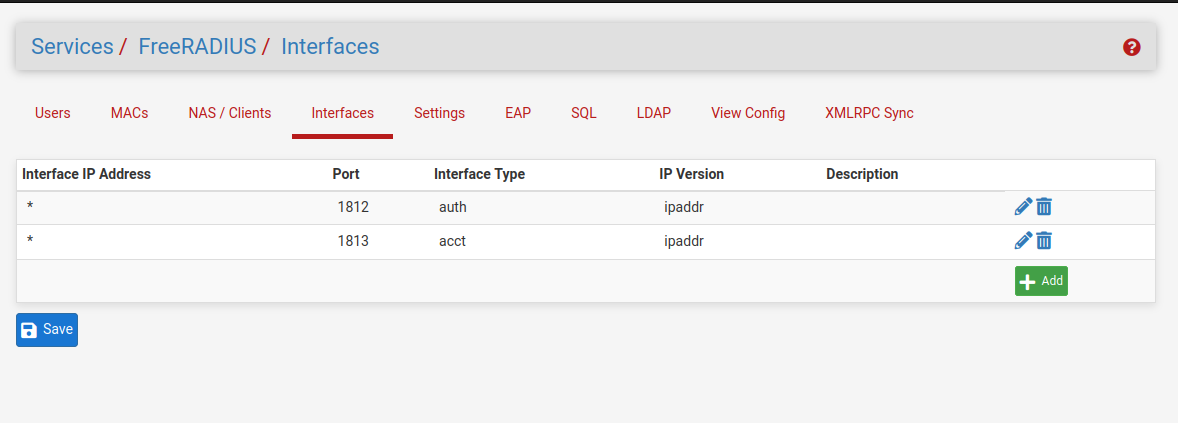
I did the NAS/Client
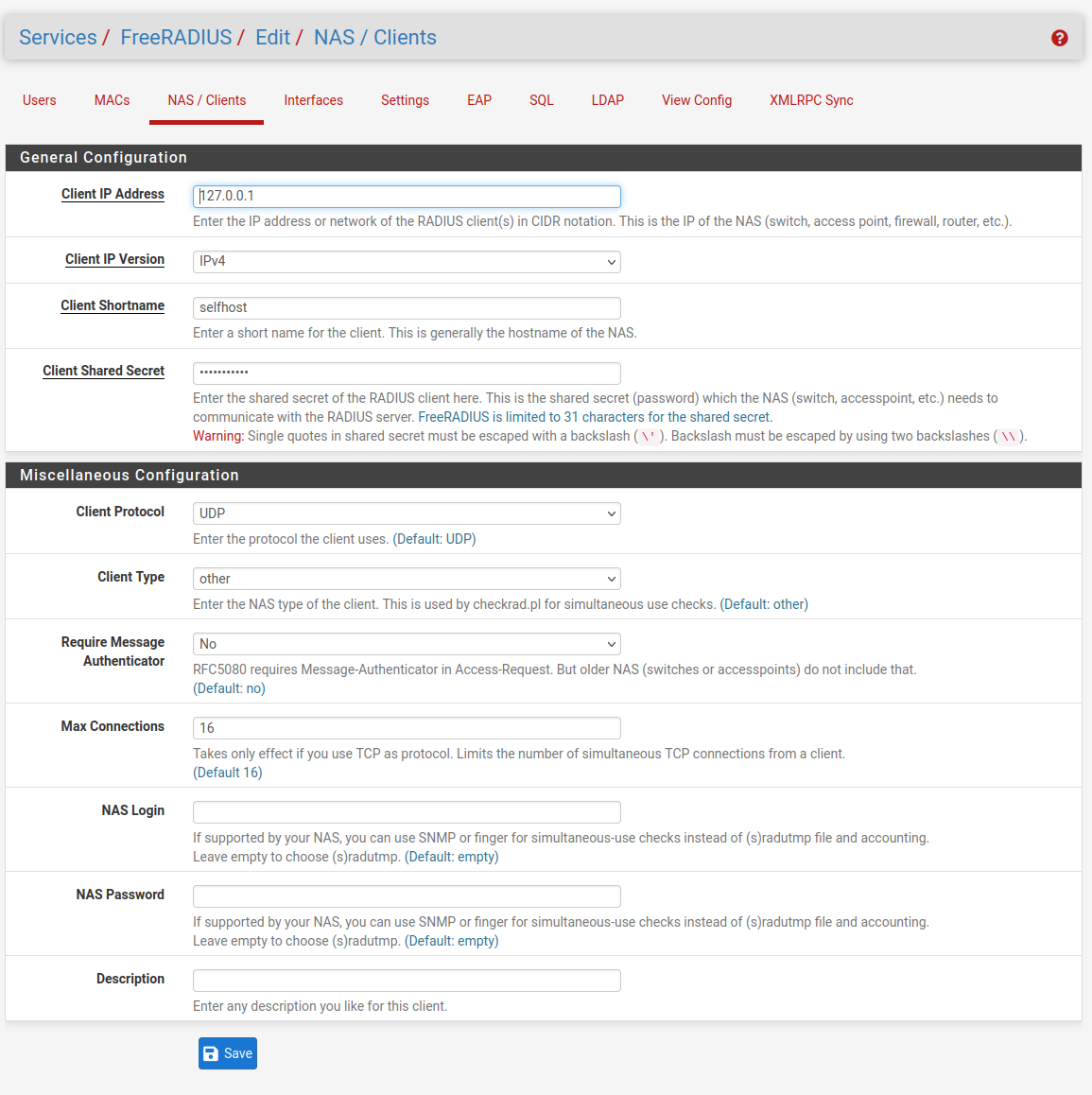
I checked disable weak EAP types: MD5 and GTC and set Default EAP type to TTLS
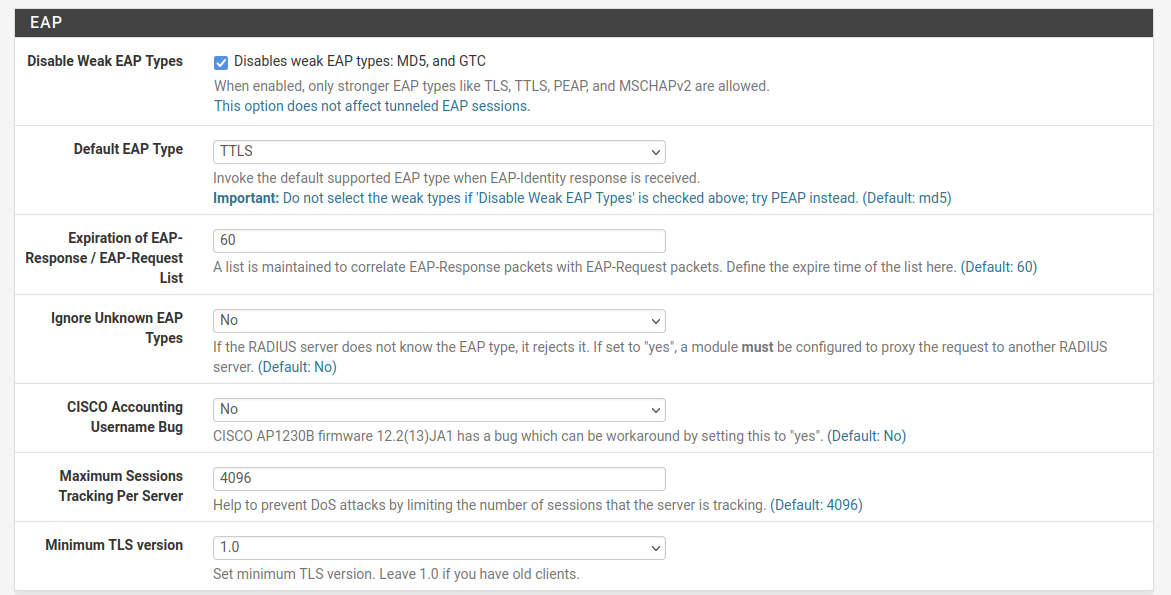
Selected SSL Server Cert to my google imported cert

Set EAP TTLS Default EAP Type to GTC
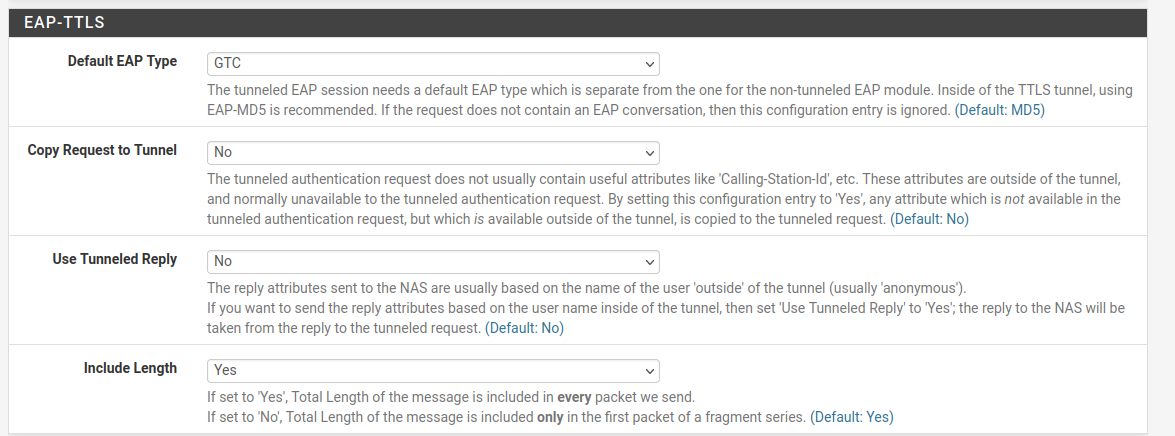
Enabled both LDAP Auth
plugged in Server address ldap.google.com port 636 and bind user / password
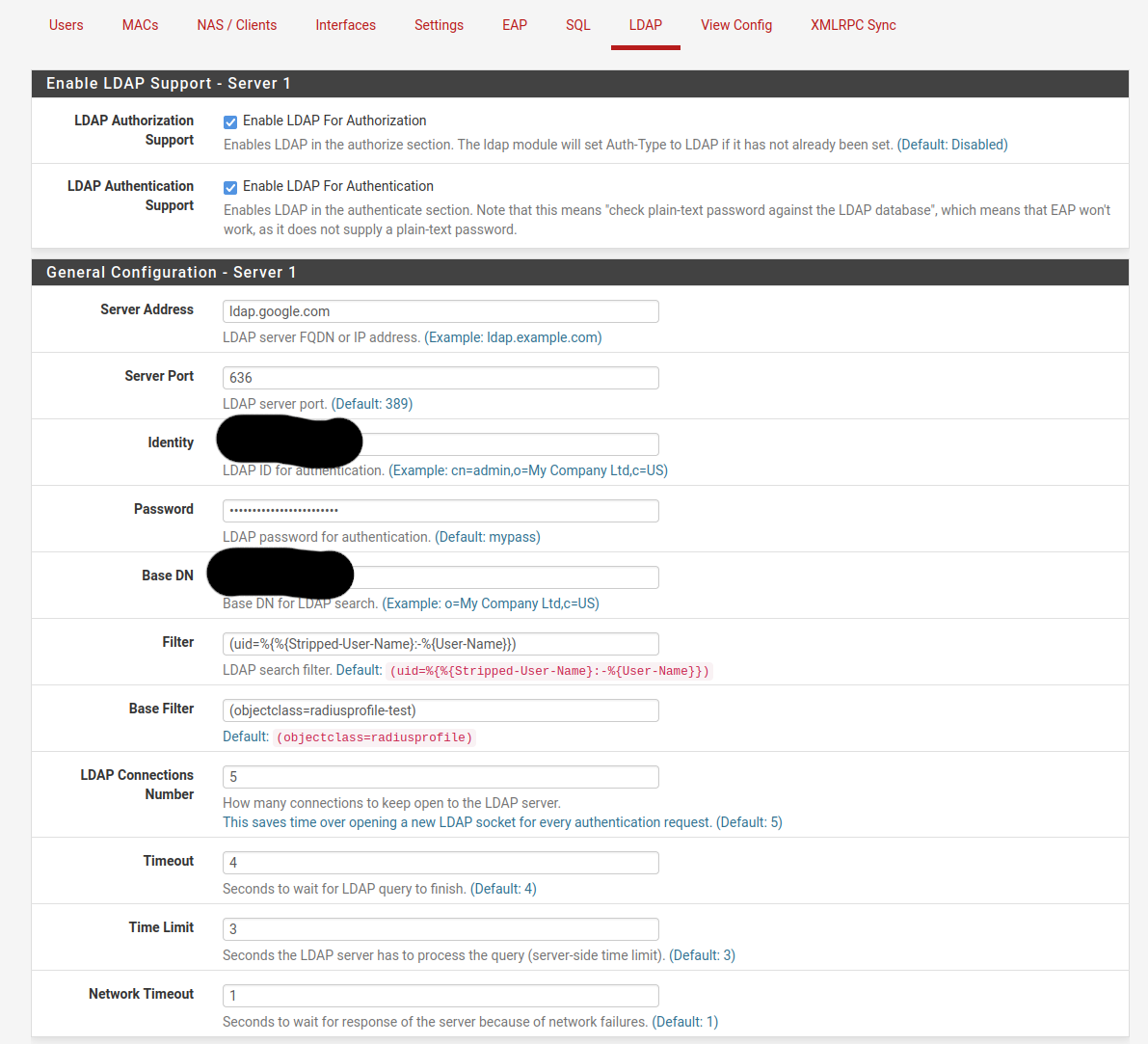
Enable TLS support, selected my SSL Server Cert imported from google and set Verification to ALLOW
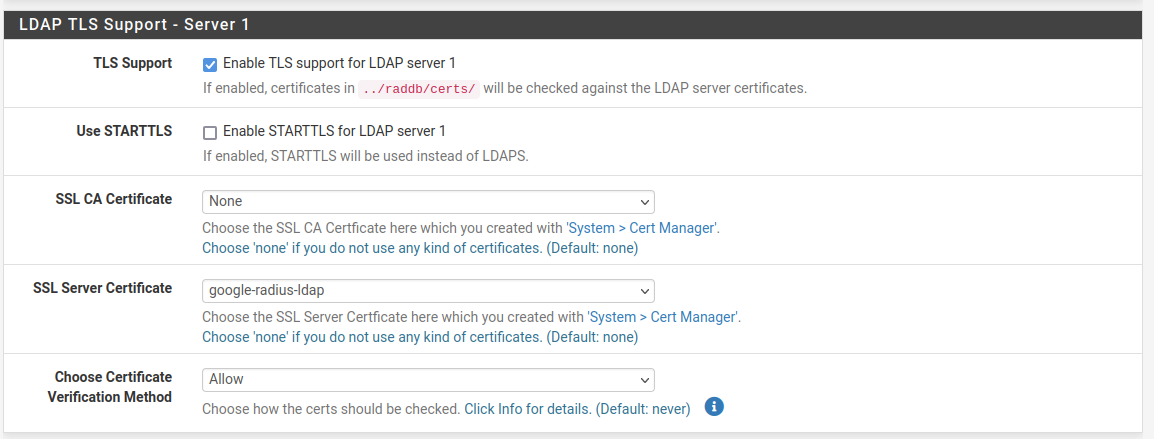
fun part editing manually:
Edit the default virtual server:
nano /etc/freeradius/3.0/sites-enabled/default which is /usr/local/etc/raddb/sites-enabled/default
In authorize section after pap add this:if (User-Password) { update control { Auth-Type := ldap } }making it look like this following the working config from the running freeradius3 server

once restarted the radiusd service I was able to authenticate using the radius server under Authentication Servers
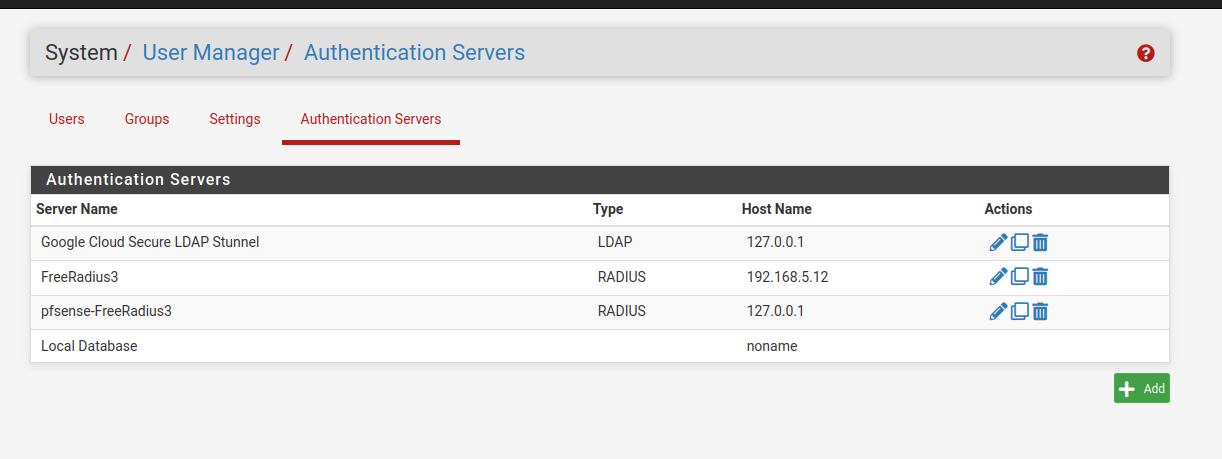
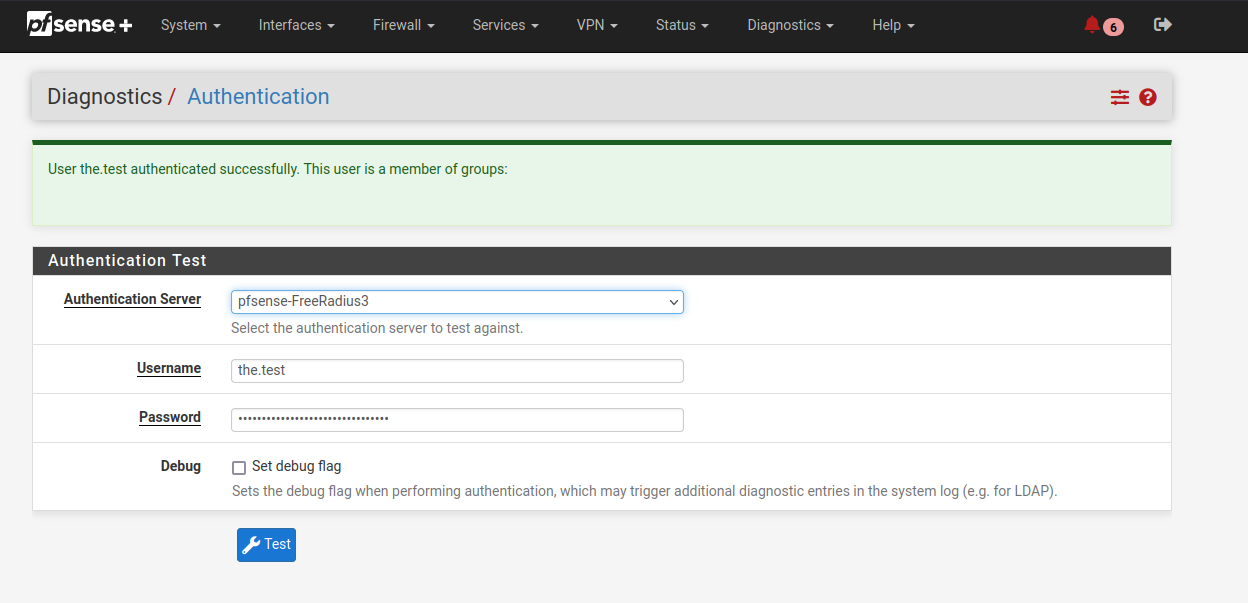
What I could use help with is getting the syntax correct for groups membership in ldap to show up in freeradius.

-
@willb0t Has anyone done this recently. ?